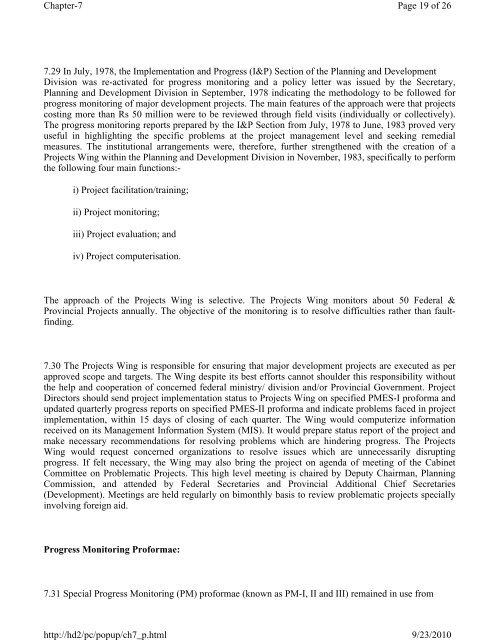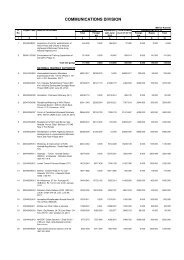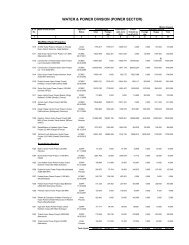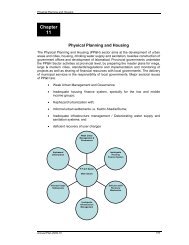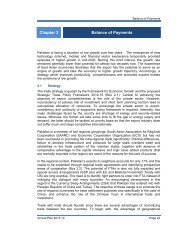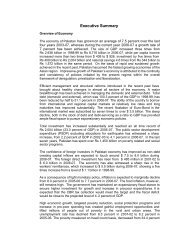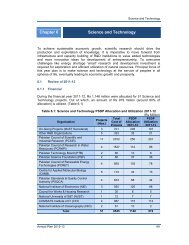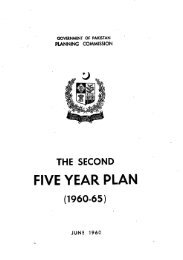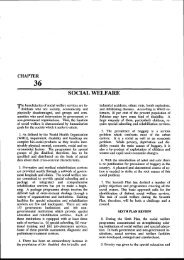Manual for Development Projects - Planning Commission
Manual for Development Projects - Planning Commission
Manual for Development Projects - Planning Commission
You also want an ePaper? Increase the reach of your titles
YUMPU automatically turns print PDFs into web optimized ePapers that Google loves.
Chapter-7<br />
7.29 In July, 1978, the Implementation and Progress (I&P) Section of the <strong>Planning</strong> and <strong>Development</strong><br />
Division was re-activated <strong>for</strong> progress monitoring and a policy letter was issued by the Secretary,<br />
<strong>Planning</strong> and <strong>Development</strong> Division in September, 1978 indicating the methodology to be followed <strong>for</strong><br />
progress monitoring of major development projects. The main features of the approach were that projects<br />
costing more than Rs 50 million were to be reviewed through field visits (individually or collectively).<br />
The progress monitoring reports prepared by the I&P Section from July, 1978 to June, 1983 proved very<br />
useful in highlighting the specific problems at the project management level and seeking remedial<br />
measures. The institutional arrangements were, there<strong>for</strong>e, further strengthened with the creation of a<br />
<strong>Projects</strong> Wing within the <strong>Planning</strong> and <strong>Development</strong> Division in November, 1983, specifically to per<strong>for</strong>m<br />
the following four main functions:-<br />
i) Project facilitation/training;<br />
ii) Project monitoring;<br />
iii) Project evaluation; and<br />
iv) Project computerisation.<br />
The approach of the <strong>Projects</strong> Wing is selective. The <strong>Projects</strong> Wing monitors about 50 Federal &<br />
Provincial <strong>Projects</strong> annually. The objective of the monitoring is to resolve difficulties rather than faultfinding.<br />
7.30 The <strong>Projects</strong> Wing is responsible <strong>for</strong> ensuring that major development projects are executed as per<br />
approved scope and targets. The Wing despite its best ef<strong>for</strong>ts cannot shoulder this responsibility without<br />
the help and cooperation of concerned federal ministry/ division and/or Provincial Government. Project<br />
Directors should send project implementation status to <strong>Projects</strong> Wing on specified PMES-I pro<strong>for</strong>ma and<br />
updated quarterly progress reports on specified PMES-II pro<strong>for</strong>ma and indicate problems faced in project<br />
implementation, within 15 days of closing of each quarter. The Wing would computerize in<strong>for</strong>mation<br />
received on its Management In<strong>for</strong>mation System (MIS). It would prepare status report of the project and<br />
make necessary recommendations <strong>for</strong> resolving problems which are hindering progress. The <strong>Projects</strong><br />
Wing would request concerned organizations to resolve issues which are unnecessarily disrupting<br />
progress. If felt necessary, the Wing may also bring the project on agenda of meeting of the Cabinet<br />
Committee on Problematic <strong>Projects</strong>. This high level meeting is chaired by Deputy Chairman, <strong>Planning</strong><br />
<strong>Commission</strong>, and attended by Federal Secretaries and Provincial Additional Chief Secretaries<br />
(<strong>Development</strong>). Meetings are held regularly on bimonthly basis to review problematic projects specially<br />
involving <strong>for</strong>eign aid.<br />
Progress Monitoring Pro<strong>for</strong>mae:<br />
Page 19 of 26<br />
7.31 Special Progress Monitoring (PM) pro<strong>for</strong>mae (known as PM-I, II and III) remained in use from<br />
http://hd2/pc/popup/ch7_p.html<br />
9/23/2010


